Its membership has included two members of Congress, two state assemblymen, two L.A. County supervisors, five L.A. Superior Court judges, an L.A. city attorney, three L.A. City Council members, and numerous South Bay city mayors, not to mention men and women from all walks of life, a variety of professions, and many ethnic backgrounds, not just Croatian.
For nearly a century, the Dalmatian-American Club of San Pedro has served as the town’s unofficial-official gathering spot. From its perch in a nondescript two-story building on a bluff overlooking the L.A. Harbor, the club has played host to everything from weddings and community events to visits from noted politicians and, of course, their legendary fish luncheons.
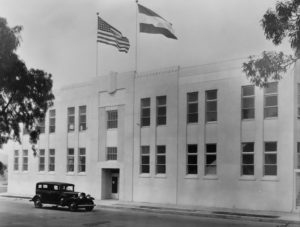
The Dalmatian-American Club (formerly the Jugoslav Club of San Pedro) has been welcoming guests for nearly a century. (photo: Dalmatian-American Club)
“To many people in the community, when you walk through the doors of the Dalmatian-American Club, you feel like you’re walking into something that belongs to you,” says Rudy Svorinich, Jr., the club’s current president. “You don’t feel like a stranger when you walk into the club. You feel like you’re entering a second home.”
Svorinich, Jr., 61, the former L.A. city councilman for CD15 (1993–2001), knows more than most about the club and its importance to San Pedro’s cultural and historical heritage. A member of the club since he was 18 years old, like many in town, he can follow his family’s roots through the club’s doors.
“Three relationships in my family met at club events. My grandparents met at an event sponsored by the club, my mom and dad met at a dance at the club, and I met my wife, Deann, at a dance at the club,” he says, laughing. His father, Rudy Sr., served as club president for four years and was on the board of directors for more than five decades, a club record.
STAKING THEIR CLAIM
“It was them staking their claim on the American dream, a place where they could proudly raise the flag of their heritage and their new home,” says Angela Romero, local historian and San Pedro Today contributor, about the club’s origins.
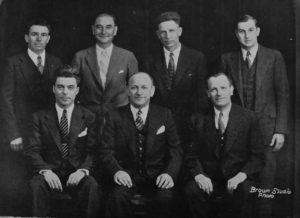
The Jugoslav Club of San Pedro Board of Directors: (first row l-r): Dinko Kovacevich (secretary), Martin J. Bogdanovich (president), S.P. Stambuk (vice-president) (back row l-r): Paul Marinkovich (director), Anton B. Jaconi (director), Jakov Despalatovich (director), Vincemt Karmelich (treasurer). (photo: Dalmatian-American Club)
On May 6, 1926, 25 men of Croatian heritage, most of whom emigrated to the United States and settled in the port town due to the town’s bustling fishing industry, formed the Jugoslav Club of San Pedro (“Jugoslav with a J because there is no Y in the Croatian language,” adds Svorinich, Jr.). The club was incorporated as a nonprofit social benefit corporation in 1927.
“The purpose of the club then, and which continues to this day, was to promote American patriotism, brotherly and sisterly love, goodwill towards all friendly nations of our country, pride in our ethnic heritage, and a general ‘good neighbor quality’ towards our community at large,” says Svorinich, Jr.
In 1934, as the United States was coming out of the Great Depression, the club’s members and their families raised $100,000 to purchase the lot and build a permanent clubhouse on the corner of 17th and South Palos Verdes streets. The clubhouse officially opened its doors on August 31, 1935.
“Paul A. Marinkovich, a building committee member and a member of the board of directors in 1935, donated $10,000 to help build the club,” explains Svorinich, Jr. “That amount would be almost $200,000 today. As the story goes, Paul came home from a building committee meeting in 1934 and told his wife, Mary, that he wanted them to donate $10,000 to help build the club. She told him that she thought that money was to buy their own house. He told her that he would make more money to buy the house, but the $10,000 was needed for the new club now, ‘for our people.’ She agreed. They donated the money, the club was built, and they bought their house a few years later.”
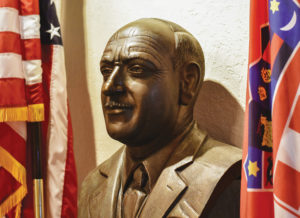
Bust of Martin J. Bogdanovich in the club’s lobby, a founding member, chairman of the club’s building committee, and president (1934-44). (photo: Dalmatian-American Club)
The president of the club and chairman of the building committee at the time was Martin J. Bogdanovich, the president of the French Sardine Company that would later become StarKist. He famously passed away inside the club in 1944 from a heart attack suffered during a special event promoting war bonds. He’s honored with a large portrait in the upstairs dining room, as well as a bust of his likeness in the main lobby that’s flanked by the United States and the Croatian flags.
In 1944, the club changed its name to the Yugoslav-American Club of San Pedro, with Yugoslav now spelled with a Y.
“That was done to reflect a growing number of the founders’ descendants being born American citizens, as well as the founders themselves becoming naturalized American citizens,” explains Svorinich, Jr.
By the time the 1950s rolled around, the club was operating on all cylinders. San Pedro was growing as a community, and club membership continued to rise. Since the clubhouse was one of the only large banquet halls in town at the time, it was consistently booked every weekend for weddings or other social events.
HITTING ITS STRIDE
The early 1960s was a time of immense change for the club. First was the launch of the now legendary bimonthly fish luncheon in January 1961, which is celebrating its 60th anniversary this year.
“There were 18 guests at the first one,” recalls Svorinich, Jr. “Those 18 guests were asked to come back two months later in March, and each of them was asked to bring a guest. Then those 36 guests were all asked to bring a guest. So, the collection grew and grew to its heyday in the late 1980s where more than 400 guests would attend.”
Today, the lunch draws about 150 to 225 guests regularly during a non-pandemic year. The club is looking forward to bringing back the luncheon — which always includes platters of swordfish, mostaccioli, green beans, and potatoes, served family-style — this summer as COVID restrictions are lifted.
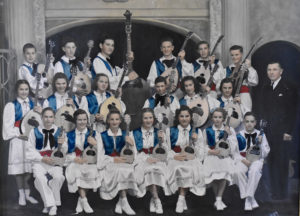 In 1962, the club’s Women’s Auxiliary was formed, followed by a management and menu upgrade with the hiring of a young Croatian couple from Wisconsin, Ivo and Radmila Lusic.
In 1962, the club’s Women’s Auxiliary was formed, followed by a management and menu upgrade with the hiring of a young Croatian couple from Wisconsin, Ivo and Radmila Lusic.
“The club has always been known as San Pedro’s hub of hometown hospitality, but we became famous in regard to our cuisine through Ivo being our club manager and Radmila as our chief cook,” says Svorinich, Jr. “They brought their wonderful cooking and hospitality to greater community awareness, which was followed after their passing by their three sons, Mike, Nick, and George.”
Radmila’s Croatian recipes for dishes like mostaccioli, sauerkraut, fried chicken, and roast beef were a hit with both club members and the San Pedro community at large. Under Ivo’s management, the club became one of the South Bay’s most popular social gathering spots and event spaces.
By all accounts, the Dalmatian-American Club’s heyday was in the 1970s and ’80s. Membership was at its peak (reaching more than 800), San Pedro’s teenage clubs were hosting dances nearly every weekend, and the bimonthly fish luncheon was now becoming the must-have ticket in town, as notable politicians, athletes, and celebrities began attending.
In the mid-1970s, the club established its Academic Scholarship Awards Program. The program has funded tens of thousands of dollars of scholarships to local students entering college through the years. According to Svorinich, Jr., even last year during the pandemic, club members and community partners donated more than $6,000 in scholarship money to six deserving students.
When the elder Lusics decided to retire in the early 1980s, their sons took over the club and kitchen management.
“When my mom and dad retired around 1980, me and my brothers, Nick and Mike, took over the club,” says George Lusic, 67, a current longshoreman. “It was a great experience for my family and me. We had good people working for us. The club would be a mess after a wedding or party on a weekend, and by Monday morning, you wouldn’t even know anyone was there.” (Full disclosure: George Lusic is my uncle by marriage.)
The club has always been a family affair stretching multiple generations. Various relatives of management and membership have worked in the club at one point or another. Many of them share the same horror stories of carrying large platters of mostaccioli up and down flights of banquet stairs.
“During the membership dinners, my dad would hire the members’ daughters as servers,” remembers Lusic.
In the mid-1980s, the United States and, at the time, the Yugoslav water polo teams visited the club for a memorable dinner prior to the 1984 Olympics in Los Angeles.
“The club has always had an affiliation with sports, just like San Pedro,” adds Svorinich, Jr. “Tommy Lasorda was a guest on many occasions.”
BECOMING DALMATIAN
The boon of the 1980s soon came to a crashing halt when war in the former Yugoslavia broke out in the early 1990s, leading to the breakup of the Yugoslav federation and Croatia declaring its independence. Tensions were running high in San Pedro’s Croatian community during this time, and a number of young Croatians took issue with the club’s name, which was still then officially called the Yugoslav-American Club but was more commonly referred to by locals for decades as “Slav Hall.”
Protestors disagreed with the use of the word Yugoslav (and the term “Slav” in general) and demanded a change, which they received in 1992 when the club officially changed its name to the Dalmatian-American Club of San Pedro.

The Dalmatian-American Club, present day. (photo: John Mattera Photography)
“The club changed its name because of changing world circumstances due to the breakup of the former Yugoslavia,” explains Svorinich, Jr. “One of the nuances is the club was never named after the country. It was named after the people. So ‘Yugoslav’ means ‘South Slav.’ We were never the Yugoslavia Club. We were the Yugoslav or South Slav club. So, when the country broke up in the early 1990s, and since the name Croatian American Club had already been taken 30 years prior by our sister club [on 9th Street], our members thought that honoring the place where our founders hailed, which was Dalmatia, was an appropriate name to name the club.”
The Lusic family ended their 40-year tenure with the club in the early 2000s, and new leadership eventually took over. A complete remodel of the lobby and a repainting of the exterior soon followed.
In September 2010, the club held one of its most important dinners to date when it played host to a visit from Ivo Josipovic, president of the Republic of Croatia. It was the first visit of a Croatian head-of-state to San Pedro.
“One thing that was of note that night, President Josipovic took a photograph with everyone who wanted to take a picture with him prior to his departure. Every single person,” recalls Svorinich, Jr.
THE COVID CHALLENGE
Of all the challenges the club has faced over its nine decades, it was the current COVID-19 pandemic that almost did them in. As a public gathering space and event facility, the club was forced to cancel all future bookings and close down in March 2020 as the pandemic gripped the nation.
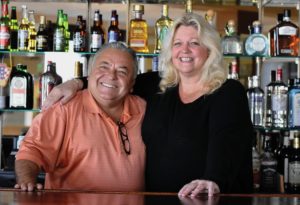
Club Facility Manager/Chief Bartender Juan Lumbreras and Banquet Manager/Administrative Assistant Renee Orefice. (photo: Danielle Svorinich, Dalmatian-American Club)
“We were in danger of closing permanently,” says Svorinich, Jr., who’s in his 16th year as club president (1988-1991, 2010-present). “By May 2020, we were in rather dire financial circumstances. We had decimated all of our checking and savings accounts, and we only had a few thousand dollars left.”
Their board of directors immediately began a fundraising drive for a Wall of Honor in the main lobby, soliciting contributions of $250 to $1,500 to purchase commemorative wall plaques. The club raised more than $112,000 in just three months.
“In 1935, the members and their families donated $100,000 to build [the club]. Then, 85 years later, the members, their families, and our community friends donated more than $100,000 to save it. Pretty amazing,” says Svorinich, Jr.
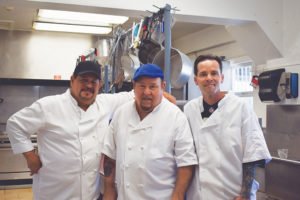
Chef Jose “Chuy” Navarro, Executive Chef Tony Pielin, and Chef David Pielin. (photo: Danielle Svorinich, Dalmatian-American Club)
The club also began selling weekly dinners for pickup. The dinners, which vary week-to-week, are prepared by Chef Jose “Chuy” Navarro, Executive Chef Tony Pielin, and Chef David Pielin, who all joined the club from the San Pedro Elks Lodge in 2014 after an arsonist destroyed the lodge. Customers can place orders online at dalmatianamericanclub.com.
“We’ve served more than 6,000 meals, and our dinners to-go average 225 guests per week,” reveals Svorinich, Jr. “Sometimes, like when we have our Traditional Slav Dinner, we get 400 guests.”
NEXT GENERATION
The future of the Dalmatian-American Club looks much better today than a year ago. Fundraising and to-go meals have kept the club solvent, even though they recently had to furlough two staff members. With COVID restrictions easing up and indoor gatherings becoming a reality again, the road to hosting large public events, especially their highly anticipated fish luncheons, is becoming shorter as the weeks go by.
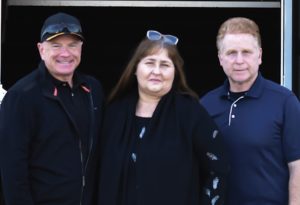
The Dalmatian-American Club Leadership: Rudy Svorinich, Jr., president, Emily Manestar, Women’s Auxiliary president, Bill Brownell, 1st vice president. (photo: Danielle Svorinich, Dalmatian-American Club)
As San Pedro’s demographics continue to evolve and more young families are leaving town for less expensive communities, there’s a worry clubs like the Dalmatian-American Club may lose their relevance. According to Svorinich, Jr., the club currently has 425 members, down 50 percent from their peak in the ’80s, but still strong.
To combat that possibility, a group of a dozen college-aged youth made up of children and grandchildren of members recently formed the club’s first Dalmatian-American Legacy Club for young people ages 21-30. Launched in February, the youth club aims to bring the club back to its peak use in the 1970s and ’80s by raising money to modernize the patio area to make it more attractive to a younger generation of members.
“From the 1950s to the ’70s, the club was known for dances that were held almost every weekend by the various clubs in town, and they want to resurrect that legacy,” says Svorinich, Jr., whose daughter, Danielle, is the Legacy Club president. “That goes back to our heyday of when the club was the social hot spot in town.”
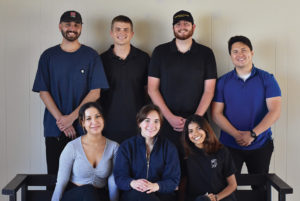
Youth Legacy Club and serving staff: (standing) Xavier Martinez, Tanner Carcamo, Jeremy Gurrola, Noe Lopez (vice president), (seated) Maria Cabanillas, Danielle Svorinich (president), and Rachel Lobo. (photo: Danielle Svorinich, Dalmatian-American Club)
There are very few institutions left in San Pedro that connect generations. Where the youth of today can revel in the same spot their grandparents, or even great-grandparents, did decades before. Tradition is important here, and the Dalmatian-American Club carries with it a legacy of memories.
“The building is the legacy of the club. They were immigrants with nothing in this land. They edified their culture in that building and became Americans. It is the symbol of their duality,” says Romero.
“There are a few institutions like us in town, but they are starting to be few and far between,” says Svorinich, Jr. “I really think San Pedro without the Dalmatian-American Club ever existing would have been less of a community. I think we symbolize what community is all about. We symbolize what family is all about. We symbolize what good friendships are all about. I think I could go as far as to say that we’re part of the glue that holds San Pedro together.” spt
For more information on the Dalmatian-American Club, visit dalmatianamericanclub.com.


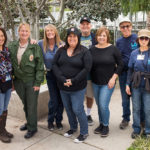
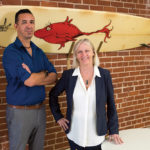
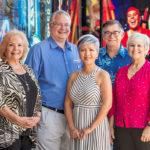
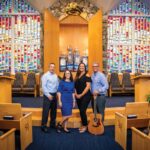
Comments